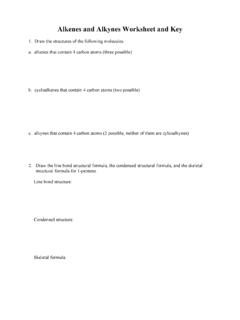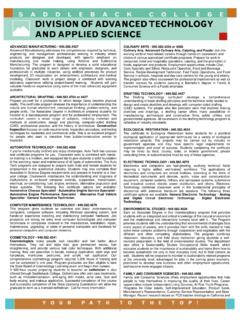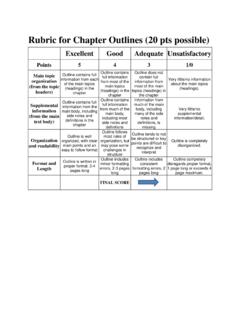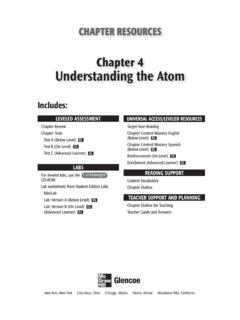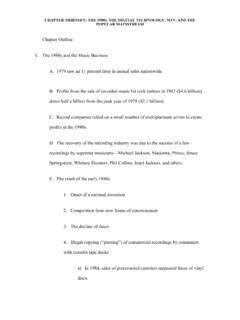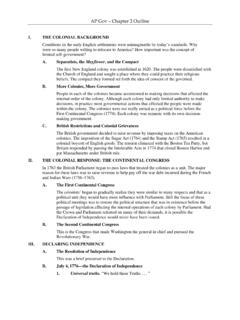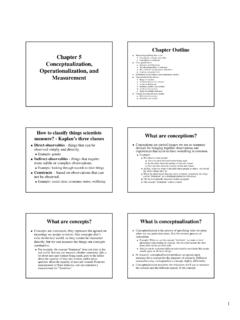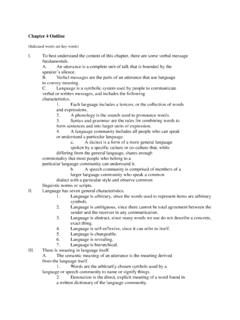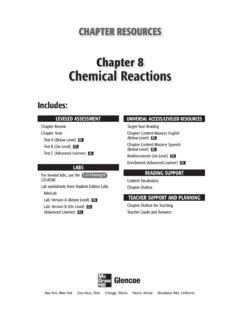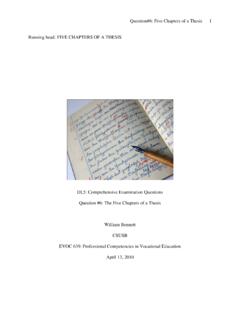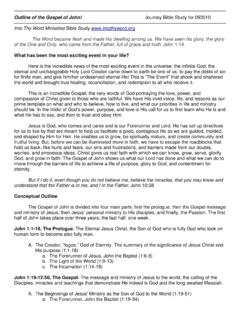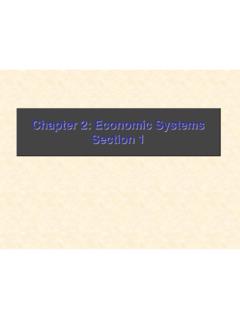Transcription of Chapter Outline Notes - Saddleback College
1 Chapter 01 - Introducing Accounting in Business 1-3 Chapter Outline Notes I. Importance of Accounting Accounting is an information and measurement system that identifies, records and communicates relevant, reliable, and comparable information about an organization s business activities. Recordkeeping, or bookkeeping, which includes just one function of accounting, is the recording of transactions and events, either manually or electronically. Technology is a key part of modern business and has changed the way we store, process, and summarize large masses of data. Technology has allowed accounting to expand to include consulting, planning and other financial services. A. Users of Accounting Information Accounting is the language of business because all organizations set up an accounting information system to communicate data to help people make better decisions.
2 1. External information users are not directly involved in running the organization; they include shareholders, lenders, directors, customers, suppliers, regulators, lawyers, brokers, and the press. External users have limited access to an organization s information but they must receive information that is relevant, reliable and comparable. Financial accounting is the area of accounting aimed at serving external users by providing them with general-purpose financial statements. 2. Internal information users are those directly involved in managing and operating an organization. They use the information to help improve the efficiency and effectiveness of an organization. Managerial accounting is the area of accounting that serves the decision-making needs of internal users.
3 Internal users and the information they require include: a. Research and development managers need data on current and projected costs and revenues to decide whether to pursue or continue research and development projects. b. Purchasing managers need data on quality and quantity of merchandise and materials purchases. c. Human resource managers need data on current payroll costs, employee benefits, performance and compensation. d. Production managers need data on costs and quality of production processes. e. Distribution managers need data on quantity and delivery schedules. f. Marketing managers need data on sales and costs to effectively target consumers and set prices. Chapter 01 - Introducing Accounting in Business 1-4 Chapter Outline Notes g.
4 Servicing managers need data on warranties and maintenance information to provide a valuable product to its customers. 3. Both internal and external users rely on internal controls to monitor and control company activities. Internal controls are procedures designed to protect company property, ensure reliable reports, promote efficiency, and encourage adherence to company policies. B. Opportunities in Accounting 1. The four broad areas of opportunities in accounting include financial accounting, managerial accounting, taxation, and accounting-related careers. 2. The majority of accounting opportunities are in private accounting as employees working for businesses. Public accounting providing services such as auditing and tax advice to businesses, offers the next largest number of opportunities while still other opportunities exist in government (and not-for-profit) agencies, including business regulation and investigation of law violations.
5 3. The professional standing of accounting specialists are denoted by a certificate such as certified public accountant (CPA), certified management accountant (CMA), certified internal auditor (CIA), certified bookkeeper (CB), certified payroll professional (CPP), personal financial specialist (PFS), certified fraud examiner (CFE) and certified forensic accountant (CrFA). II. Fundamentals of Accounting A. Ethics A Key Concept Ethics are beliefs that distinguish right from wrong; they are accepted standards of good and bad behavior. 1. Ethical behavior is important in all successful organizations. Users must be able to trust accounting information. Good ethics are good business. 2. The AICPA and IMA have set up ethical codes of conduct.
6 B. Generally Accepted Accounting Principles Financial accounting is governed by rules known as generally accepted accounting principles, GAAP. GAAP aims to make accounting information relevant, reliable and comparable. The Securities and Exchange Commission (SEC) has legal authority to set GAAP. 1. Setting Accounting Principles a. The SEC has delegated the task of setting GAAP to The Financial Accounting Standards Board (FASB), a private group that sets both broad and specific principles. Chapter 01 - Introducing Accounting in Business 1-5 Chapter Outline Notes C. International Standards. The International Accounting Standards Board (IASB) issues International Financial Reporting Standards (IFRS) that identify preferred accounting practices.
7 The FASB and IASB are pursuing a convergence process aimed to achieve a single-set of accounting standards for global use. Currently, there are two sets of accepted accounting principles in the : GAAP for SEC registrants and IFRS for SEC registrants. D. Conceptual Framework and Convergence. The FASB and IASB are attempting to converge the conceptual framework. The framework consists of: Objectives providing useful information to investors, creditors, and others. Qualitative Characteristics requires that information be relevant, reliable, and comparable. Elements defines items that financial statements can contain. Recognition and Measurement sets criteria that an item must meet for it to be recognized as an element, and how to measure that element.
8 Chapter 01 - Introducing Accounting in Business 1-6 1. Principles and Assumptions of Accounting Accounting principles (and assumptions) are both general (basic assumptions, concepts and guidelines for preparing financial statements) and specific (detailed rules used in reporting transactions). The principles, assumptions and constraints discussed in this Chapter are: a. Cost principle accounting information is based on actual costs incurred in business transactions. Cost is measured on a cash or equal-to-cash basis. b. Revenue recognition principle provides guidance on when a company must recognize revenue; to recognize means to record it. Revenue is recognized when earned. c. Expense Recognition or Matching principle a business records expenses incurred to generate the revenue reported.
9 D. Full disclosure principle requires a company to report the details behind financial statements that would impact users decisions. e. Going-concern assumption accounting information reflects a presumption that the business will continue operating instead of being closed or sold f. Monetary unit assumption transactions and events are expressed in monetary, or money, units (generally the currency of the country in which the business operates). Chapter Outline Notes g. Time period assumption presumes that the life of a company can be divided into time periods and that useful reports can be prepared for those periods. h. Business entity assumption a business is accounted for separately and distinctly from its owner(s).
10 A business entity can take one of three legal forms: i. Sole proprietorship is a business owned by one person that has unlimited liability. Requires no special legal requirements. The business is not subject to an income tax but the owner is responsible for personal income tax on the net income of the entity. ii. Partnership is a business owned by two or more people, called partners, who are subject to unlimited liability. No special legal requirements must be met. The only Chapter 01 - Introducing Accounting in Business 1-7 requirement is an oral or written agreement between the partners which usually outlines how profits and losses are to be shared. The business is not subject to an income tax, but the owners are responsible for personal income tax on their individual share of the net income of the entity.





